|
|
Welcome to my travel log! You will find here a lot more than in the travel reports, stripped from political correctness. Enjoy! 
Dec 21, 2002 07:00 PM Namibia - the Skeleton Coast & the seals
 The last day on the Northern Adventure led right along the Skeleton Coast. I did not however end up in the national park of the Skeleton Coast but I was pretty close. By the way, the skeleton in the name is not connected to the numerous shipwrecks stuck in the desert by the coast. It is related to the strong currents and swirling fog. However, many pictures of those wrecks are being taken everyday and the term became synonymous with the shipwrecks. Well, it doesn't matter.
The last day on the Northern Adventure led right along the Skeleton Coast. I did not however end up in the national park of the Skeleton Coast but I was pretty close. By the way, the skeleton in the name is not connected to the numerous shipwrecks stuck in the desert by the coast. It is related to the strong currents and swirling fog. However, many pictures of those wrecks are being taken everyday and the term became synonymous with the shipwrecks. Well, it doesn't matter.
On the Skeleton Coast there is one of the things I wanted to see, although I wish I had never had – the Cape Fur Seals at the Cape Cross. The 'seals' or even Cape Fur Seals are actually not seals at all but specie of a sea lion.
The number of them exceeds 50,000 and at the time I went, there were many cute black babies. They were very cute but a lot of them were also dead or almost dead.
The majority were just two weeks old and it is said that they die because they lose their mothers. The mothers must swim back to the ocean for food to ensure they have enough milk to feed, but when they come back, they cannot find their babies. The babies are very mobile and when hungry (which is almost all the time) wander off and around looking for their mummies. It is however so hard for such a small baby to find its mother in the crowd of 50,000. Imagine, that human kids can get lost in a supermarket or in a medium sized shopping mall. How about in a 50,000 people city?
Unfortunately, the area of Cape Cross is burdened with a horrible smell, very difficult to describe in order to illustrate its awfulness. It comes from the dead bodies of the seal babies. This terribly repulsive smell drills through your mind, through all of your senses, killing one thought after another very, very, very slowly. It is one of those experiences one never forgets! I'm serious!
I had to leave very soon as the smell was unbelievable and I still had not had lunch and I knew that in the future I would want some. I realised that I stayed there too long anyway because all my clothes smelled terribly already. I returned to the vehicle and decided to think about those poor baby sea lions from a distance. I very much preferred that way.
I also had another interesting chat with the now legendary guide. I learned that the Herero usually do not mind to be called by the name of their tribe (i.e. Herero) instead of their first name, but the Damara do. This is the Damara however who call others by the name of their tribe rather by their proper first name. Why is that then that they prefer to be, what definitely they themselves perceive as, rude. Why am I on this subject again?
|
Dec 20, 2002 07:00 PM Namibia - Damaraland & Rock Engravings
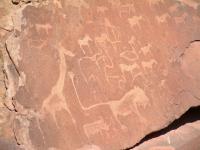 The land below Kaokoveld is called Damaraland from the name of the Damara people who live there. The area is famous for impressive mountain formations, the highest peak of Namibia, ancient rock engravings and strange pattern of people's behaviour, which could be perceived as condescending and possibly even rude.
The land below Kaokoveld is called Damaraland from the name of the Damara people who live there. The area is famous for impressive mountain formations, the highest peak of Namibia, ancient rock engravings and strange pattern of people's behaviour, which could be perceived as condescending and possibly even rude.
The Aba Huab campsite is the place that I was fortunate to visit and even stay at. It is nicely located near the riverbed and in a convenient vicinity to the organ pipes rock formations. There was absolutely nothing else around, just bush and bush.
The service at the lodge's bar and restaurant was extremely rude, grumpy and very, very slow. They behaved like they were so unhappy that we were there and therefore they have to do a little work. Like we were disturbing them with their nothing-doing. They also happily rip everyone off and expediently forget to give back change. For a bottle of Amarula they charged five times more than in a regular shop. That is nothing however compared to the 10 Namibian dollars for charging a digital camera battery from their power socket.
At the Klein Aus Vista lodge, near Kolmanskoop, I was charging my batteries five times over and they did not charge me anything!
The place has a great potential, though. The building itself is very interesting architecture wise and situated in an attractive surrounding. There was one thing missing – a swimming pool. I later found out however that they would not be building swimming pools because of the desert elephant.
The elephant can smell the water from a huge distance and would definitely come to the lodge. The proximity of the riverbed is an additional factor. If the elephant found people in the water, it would have to pulled everyone out and consequences of such an event could be, or worse, would certainly be tragic. The owners would therefore have to fence the property tightly and strongly to protect the guests from the animal and that would have negative impact on the attractiveness of the campsite and quite possibly on the financial return of the place as well.
Well, the reason we were heading in the Aba Huab direction in the first place was to see the ancient rock engravings in the area of Twyfelfontein. I have to admit that I expected a lot more.
The rock engravings were nice but not necessarily exquisite. There was something amusing about them however – different sources state different age of the engravings. The problem is that the difference between one and the other source is larger than four thousand (4,000) years. So much for accuracy or thoroughness of the archaeological research for that matter!
Well, the on-site guide clearly articulated that the engravings were 5,000-6,000 years old but then showed also paintings and other engravings that were different from the first set she pointed out and these were only 1,000 years old or so. This therefore could have been the reason of the significant discrepancy in the age of the engravings stated in various sources.
The guide, a female, was an interesting one too. She was Damara and, like all the Damara I met, was very reserved and not very friendly at all. She made an impression that she did not enjoy her work at all. She was almost as bad as me in this subject, but about this shush... The entire rock engravings tour in the mountains was supposed to last an hour. She was rushing from one engraved rock to another with a speed that could only suggest that she wanted the tour to be over as soon as possible. Like she's had enough of guiding right after the very first rock.
I, at the other hand, just wanted to contemplate and take pictures but she wanted to rush through the entire trail. She would just say 'ok?' in her nice black girl voice with a very distinct accent, indicating that she was done with this rock and wanted to move to another one.
Down, back from the tour, at the park station the complete assembly of the guides said that they wanted to sing to the entire group of ours. It was just before Christmas, so they sang some carols in their own language.
They could sing very well and created a nice atmosphere. Although it was so obvious that they did not put a lot of heart in their performance. They sang without passion and looked like they were singing because they were dead bored, nothing more. That was hugely disappointing, because had one been not able to see their no-expression faces, it actually would have been a very nice moment as they proved a lot of singing talent. What a pity that they sang like they did not really want to.
Have I mentioned that the night sky in Africa is the most striking? I think I have. The number of stars that could be seen with naked eye at one time is mindboggling. I could not resist taking a photograph of the stars and one of my favourite constellations - the Orion, which in the southern hemisphere is up side down – check out the picture on one of the previous pages.
Taking photographs of a night sky is truly breathtaking and somewhat philosophical. I remember when I was kid I always liked to lay down under on open sky and look at the stars imagining what the entire cosmos could be containing, how far to the stars it could be and whether we will ever find out what it is like at the other side of the universe. Isn't it disappointing that we humans still didn't get very far?
The infinity of the universe mathematically guarantees, almost in 100%, that there is, somewhere, deep in the space, a planet like Earth and that someone, at the other side, is taking a photograph of our planet in the same way at the same very moment. So, it is like photographing oneself in someone's lens.
This concept comes from John Hodge and has been used in one of the American adventure films, but I definitely like the idea!
When I was planning the trip in the Damaraland, I wanted to go to Uis. When I finally went there it actually turned out that it is a civilised, clean, flowery place but a bit boring.
It may also soon become a ghost town as the Uis's tin mine discontinued operations a few years ago and there is virtually no alternative employment in the vicinity. Sad!
There, in Uis, I also found out that to sell semi-precious stones in Namibia one requires a license. All those poor street stone merchants take their chance nevertheless. At the other side, the owners of the somewhat well run supermarket made it all very clear that any street merchants are not welcome on the store's property. Therefore, the chance takers hunt the infrequent tourist to sell some of the rocks.
These merchants are actually quite cheeky, I have to say. One of them asked me if I could buy them some bread, so I went back to the shop and bought them two nice fresh loafs. When I got back and handed them over, they asked me about butter, jam... no, that was too much! Even for me! Give them one finger and they want to take the whole hand. Cheeky, too cheeky.
|
Dec 19, 2002 07:00 PM Namibia - Opuwo & Ova-Himba
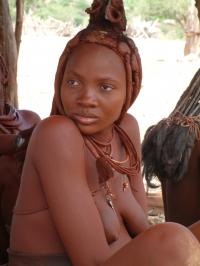 There is a land in northern Namibia that is already legendary. It is the Kaokoveld. It is renowned for impassable roads, or rather a lack of roads, desert elephant and friendly, beautiful red people who live their traditional way – the Ova-Himba.
There is a land in northern Namibia that is already legendary. It is the Kaokoveld. It is renowned for impassable roads, or rather a lack of roads, desert elephant and friendly, beautiful red people who live their traditional way – the Ova-Himba.
Well before the trip, I already wanted to take loads of pictures of these people as I saw their pictures in many publications about Namibia. When I was planning to come there by my own, I did not realise that I would need a secret weapon.
The weapon was an interpreter. Ova-Himba do not speak any other language but their own. So, had I gone there on my own I would have not enjoyed it like I actually did, and what more important the Ova-Himba would not have enjoyed it this much.
My actual secret weapon was, again, Kenny. Kenny, as Herero, could converse with them, because they are a tribe-branch of the Herero. My secret weapon provided for many various tricks and allowed for taking loads and loads of pictures continually.
There was this particularly beautiful woman, who was actually expecting a baby quite soon, caught my eye and I just could not stop photographing her. She could so much be a Naomi Campbell type of super model. Sweet! I am not sure if I have seen a more beautiful woman in flesh in my life. It was intense!
The visit to Ova-Himba was well planned beforehand. Kenny has decided to take to the village two large sacks of maize, loads of sugar, salt, and household items. The idea was to give all these goods to the headmistress of the village, and then sit down and talk to all others in the village for as long as we wanted.
But this is what the villagers wanted the most and appreciated very much. They were so happy to be in the centre of attention, been asked a lot of questions. They also wanted to ask us questions – to mingle. I heard that other tourists, who go to Kaokoveld, just pass by and take a few pictures from a distance or from waist without expressing any interest in the culture and life of Ova-Himba, are usually not appreciated very much.
The Ova-Himba paint their bodies with a substance of brown-red colour. I cannot remember what exactly they are using, but I think it is mud mixed with Vaseline. They do it for two main reasons: a/ cosmetic purposes and decoration; and b/ protection from mosquitoes and other insects.
Only women and children are painted, though. This obviously makes sense because the women want to look beautiful and want to protect their children from insects. The men do not care that much, but I do not know for sure because I have not met any.
The villagers were all so excited that we were sitting so close with them, talking and joking that they made some of the paint and smeared a bit on our arms and legs. That was funny, but the funniest was the German guy who thought the paint would never go off and he would be partially red until the end of his life.
That German was actually very cheeky with the OvaHimba asking them how they are managing to make so many children. Kenny was so embarrassed to translate these questions. Something tells me however that such personal and maybe even intimate questions brought us close to them and they had no problems with answering such queries. The woman-boss of the village was so exited and happy that we took so much time to spend with her village that she had tears in her eyes. She was quite old, I think over 90 years, and it made me ever so happy that I could provide for another pretty picture she will take with her to the 'next place'.
When I was later talking to Kenny, I told him a bit about Europe and Poland, and England. When he heard that there are 80 million Germans in Germany, he could not believe me. He then said 'how dared he asking me questions about making so many children when in Namibia there is maximum two million people. It cannot possibly compare with Germany! I will now be asking him how to make children.' I could not agree more.
So, after spending a few hours with OvaHimba I would like to say that they are sweet tooth people and the elderly women could be very bossy. They leave an impression of having strong personalities. They have lovely kids who would hold on to you grabbing your hand for the entire day and look straight in the eye.
The women are responsible for building the houses, which are made of wood, tree branches, mud and cow excrement. A man can have many wives and a woman can have children with many different men. Men stay away from village for many months to look after cattle.
Alcoholism unfortunately is increasingly becoming a problem amongst the Ova-Himba and the so-called traditional (some sort of home brew) beer is very available and affordable almost for anyone, as it costs only one Namibian dollar.
When the men come back from their long cattle looking after, they are so happy to be with their women that they drink a lot. Well, should I blame anyone for drinking too much because of a woman, or women? Well, I am not sure. Though there is something in it, innit?
On the way to the village, we stopped to help some other local people with petrol as they ran out of fuel. While we poured some gasoline to their car, the entire group of approximately fifteen people suddenly started to sing. They definitely could sing! It lasted maybe ten minutes but the entire situation was surreal!
Kaokoveld reminded me a little of Madagascar. The landscape was similar and so was the quality of roads. Also, many people waved at passing cars, which was truly exciting! I was not sure what would be connecting these two lands on this at-passing-vehicle-waving platform, but I guess the number of cars that passed through the villages did not exceed one per day or so. The waving feels so friendly and welcoming and adds this specific spice to the trip that makes the holiday utterly unforgettable.
|
Dec 18, 2002 07:00 PM Namibia - Etosha; the last day
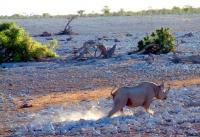 In Etosha, although it is a great park, one needs the skills of spotting the animals. There are so many of them there but it is not easy to see them through the bush, through the trees, etc. In addition to all the big land-based creatures, there is a wide range of birds to be encountered in the park.
In Etosha, although it is a great park, one needs the skills of spotting the animals. There are so many of them there but it is not easy to see them through the bush, through the trees, etc. In addition to all the big land-based creatures, there is a wide range of birds to be encountered in the park.
I am not sure how many species of the of birds there are in Etosha, but with the great help of Kenny I spotted the following: Pale Chanting Goshawk, Tawny Eagle, Black Stock (I originally thought it was a Marabou), Southern Yellow, Hornbill(unexpected visitor to the Okaukuejo waterhole), Glossy Starlink (cheeky, nosy and noisy), Secretary Bird, Blue Crane, Cory Bastard and Lappetfaced Vulture.
Some of the birds I have recognised myself, but most of them I could not identify, so I showed my pictures to Kenny, who either knew the answer straight away or consulted his birds encyclopaedia.
Kenny also told me, to my great, astonishment, that the elephant is Africa's best swimmer. Definitely the best amongst the Africa's Big Five; the lion, the leopard, elephant, the buffalo and rhino.
The elephant is also the true king of the Jungle, because it is the largest and is not afraid of any other animal. When I heard that, I immediately asked why everyone was calling the lion the king of the jungle. It appears that the lion is considered the king because it is the predator of predators and is the king of carnivores. Kenny said 'they say the lion is the king, because it has teeth'. Fascinating!
Everyone however knows that it the elephant who rules Africa.
What was new for me also was to find out that ivory was again legal in Namibia as the elephant is no longer endangered specie in Namibia. The elephants must be actually culled sometimes, as they damage farms. Who would imagine that!
Oh, but although elephants are no longer endangered, most European countries still uphold the embargo on ivory import. Hmm...
The time in Etosha flew! Although the middle of the day was unspectacular (the animals hide from the lethal sunrays in the shade of large bushes), the excitement of the mornings and evenings, and nights was overwhelming. The best experience from Etosha I will always remember is the Okaukuejo waterhole with its incredible animal show. The worst one was the dust in the western part of the park, which covered me from head to toes.
|
Dec 17, 2002 07:00 PM Namibia - Etosha National Park
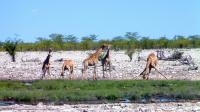 One day, it was extremely hot, the temperature was exceeding 52C (125F) in the sun and it may have contributed to the fact that a lot of animals arrived at the waterhole well before sunset. This made a miraculous opportunity to take some incredible photographs. That night, there must have been at least 15 rhinoceroses around the waterhole and at least 9 of them at one time. Plus there were a number of elephants with babies.
One day, it was extremely hot, the temperature was exceeding 52C (125F) in the sun and it may have contributed to the fact that a lot of animals arrived at the waterhole well before sunset. This made a miraculous opportunity to take some incredible photographs. That night, there must have been at least 15 rhinoceroses around the waterhole and at least 9 of them at one time. Plus there were a number of elephants with babies.
Suddenly, two male lions appeared by the waterhole. Lions were so much hoped for by the majority of the people around the waterhole. The lions however had a very quick sip and after spotting a few rhinos with babies, they decided to back off for a while.
Unfortunately, a very fat and disgusting arsehole from South Africa kept frightening the lions away with a very powerful spotlight, powered by truck battery. It did not help to tell him off and educating that lions are nocturnal animals and they do not like to be flashed a powerful spotlight straight in their eyes. This stupid prick was arguing that they would not be frightened at all but switched off the light for five minutes. Then, he started all over again and a co-traveller of mine had to tell him off again.
I have not seen or met such a rude individual in my entire life. He was not there on his own! He was a guest in the country and was supposed to listen to an experienced local game guide who told him so. Furthermore, it was later proven that he was so wrong because the lions never came back that night. These are the South African Afrikaners for you!
A similar Afrikaner, Johann, this time from Namibia, was my safari guide for the Southern Swing with the Wild Dog Safaris. I have to admit that I categorically did not enjoy his company, not mentioning the service. He was rude and extremely aggressive. His approach was not professional and no-one from the group liked him. He was also using abusive language and one girl from the group could not stand it and a massive argument exploded between these two in the front of everyone.
There could not possibly be any objective reason for such aggressiveness towards people from all over the world. They were in fact his clients and should have been looked after, but I guess this did not mean anything to him. He had absolutely no concept of working in the services sector.
These two individuals put me off travelling to South Africa.
Fortunately, for the Northern Adventure, involving Etosha, I had an excellent guide, named Kenny. Very polite and super professional. The most important thing however was that Kenny had a superb and brilliant sight! With naked eye he could spot a small warthog from a mile's distance from behind a bush, and that was unbelievable and most impressive.
Furthermore, he could speak some of the local languages and cooked magically. His food was the best and I could not believe how he could make a meal of nothing. I noticed that he was using some special type of spices, which must have contributed nicely to this miraculous cooking.
|
Dec 16, 2002 07:00 PM Namibia - The Northern Adventure; Etosha, Okaukuejo
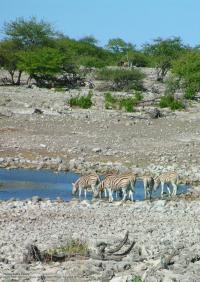 Etosha is the first stop on the Northern Adventure Safari trip with the Wild Dog. It is the prime national park in Namibia and one of the largest three, along with the Naukluft Namib Desert and Skeleton Cost. The area is so vast, the Etosha plain is clearly visible from Space. It looks like a white stain on the surface of our planet (see the satellite picture with the route).
Etosha is the first stop on the Northern Adventure Safari trip with the Wild Dog. It is the prime national park in Namibia and one of the largest three, along with the Naukluft Namib Desert and Skeleton Cost. The area is so vast, the Etosha plain is clearly visible from Space. It looks like a white stain on the surface of our planet (see the satellite picture with the route).
It is the place where the Etosha Elephant lives, together with white and black rhinos as well as lions. Etosha is the most important tourist destination for anyone visiting Namibia. So there I was, too.
Since I did not enjoy the group of the Southern Swing, I was very happy to change company for the seven days northern safari ride. This time, there were only three Germans (uff...) and the rest was made of three British, one French and an Italian. The group was a lot more age diversified and significantly more relaxed.
So, again I was on the road to the north. Right after Windhoek, there is this roadblock where the police do passport and luggage check. It is in fact very annoying and slows down the travel considerably. The police are not looking for anything, they just have to be doing something to fight the boredom.
Actually, one of the officers said to me that they were immigration control. What, in the middle of the country? Immigration control is usually at the country frontiers, right?
Oh, there was one thing I did not like about the northern trip right from the beginning – it was the vehicle. Stupid minibus. As we broke the Landcruiser on the southern trip, there were not enough of 4WD vehicles, so the company gave us this horrible Toyota minibus. It was quite comfortable, I have to admit but the terrible thing about it was a lack of air conditioning.
You need air conditioning in Namibia for two, very good reasons. The heat is not the first one, it is the second. The first, most important reason is the dust. The majority of the roads are the gravel roads so the dust becomes a serious problem. Really. With no air conditioning, you tend to open the windows hoping the heat will not cook you. However, at the same time the dust gets in to the vehicle, and it gets literally everywhere!
Well, the most important issue for me was that I was on holiday, in relatively good company and going to Etosha National Park.
The only thing I wanted to do in Etosha was to take a picture of a drinking giraffe. Even the elephant was not a priority, or the rhinoceros. Or a giraffe! No, it had to be drinking giraffe. I was getting so impatient that people had to keep reminding me that there will be plenty of them and that they will be very close.
All of them were right. Giraffes are common were they live and it is quite easy to photograph them. In addition, most of the animals viewed in Etosha are actually caught while drinking. There are numerous waterholes, also clearly marked on the maps, and three of the cleanest ones are surrounded by park campsites and lodges.
The first one and the largest is Okaukuejo. It is a modern camp with excellent facilities. There is an excellent restaurant, bar and swimming pool.
Great place it is, however, although I'm pretty sure not specific to Okaukuejo, there are no locks in showers or toilets. It is amazing how this is consistent across the entire Namibia. I could not stop thinking why it would be. I can imagine that Namibians would like to be seen under shower - most of them are good looking people, but what could be a reason of wanting to be seen whilst taking a crap? Not having a lock in the toilet adds a lot of adrenaline to the blood circulation, so maybe that's it. At the other hand, taking a crap usually widens one's eyes and pulls almost 80% of muscles of the face. In other words making one a lot less attractive. So, there must be some other reason. I'm still working on it.
Back to the story, though. There is absolutely one item that must be told about Etosha. Let's call it 'the most fantastic spectacle at waterhole'.
In the evenings, when most of the animals come to have a drink, rolls of photographic film and digital camera memory cards get full in a heartbeat. The waterholes turn into some sort of a theatrical stage where animals subconsciously perform a mind boggling show.
It goes like this: at the waterhole, there is a hierarchy and different species of animals wait their turn. It may not necessarily be associated with the animal kingdom's hierarchy but be rather connected to the level of cowardness the particular species have.
Since the zebra are the least courageous, they are the first at the waterhole before other animals appear and then, if necessary, wait their turn later on when others have arrived. They can be waiting in a long line for hours and hours however.
The waterhole is like a round stage and animals start their drinking tour from the left hand side, spend some time at the centre and leave by the right hand side. Every single one of them! That is already amazing.
|
Dec 15, 2002 07:00 PM Namibia - The Kalahari and the San people
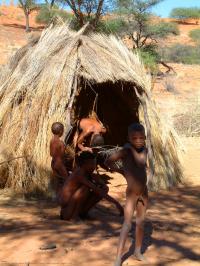 The last stop of the Southern Swing safari trip was at a lodge and campsite named Intu Africa (in relation to the superb film Out of Africa) right in the desert. The lodge was quite nice and of one of the most expensive in Namibia but the campsite, marvellously situated in the dry riverbed, was neglected and the facilities could have been improved a lot.
The last stop of the Southern Swing safari trip was at a lodge and campsite named Intu Africa (in relation to the superb film Out of Africa) right in the desert. The lodge was quite nice and of one of the most expensive in Namibia but the campsite, marvellously situated in the dry riverbed, was neglected and the facilities could have been improved a lot.
There was no hot water available in the shower unless one brings own firewood to heat the water tank. I would have hated the place had the scenery been not spectacular.
The riverbed was massive and the surrounding dunes striking. The sunset colours were again nicely exacerbating the vividness of the place. I had been in Namibia for two and half weeks and I still could not believe that sand could be so red.
In Madagascar the soil is also red, but it is more vein blood red. Dark, almost brown. In Namibia the sand is red of various shades, from light crimson through vivid cherry to deep red. I just could not get used to it.
Visiting Intu Africa was not even in the original plan as, according to the information in the Wild Dog Safaris brochure and on the Internet, the last day was supposed to be spent in the area of Bukkaros Volcano and the forest of the Quiver Trees. I was already beginning to be disappointed until I was taken on a short game ride and an exciting Bushmen walk.
Bushmen are people related to the San tribe that occupies Kalahari in Namibia, Botswana and partly South Africa. They go through life in a traditional nomadic way living on gathering and game hunting. They are masters of living on the desert, are unbeaten at finding water in the driest places and defending themselves from lions, leopards and other man-eaters.
The walk in the Kalahari was really interesting and the Bushmen, one of whom was named Chinco, were very keen to show everything about their way of life and answer many questions. They actually liked better those people who asked many questions. It was very important to show some interest to them rather than just taking picture after picture. They were so excited to answer any queries but I have a feeling that they happily lied to us if they did not know the right answer.
Before I met the San, I heard about the language they speak. It is based on clicks (with the tongue), which it is not easy to speak. Meeting with the Intu Africa Bushmen was however the first time that I heard it spoken. I even tried to pronounce some of the names of the San guides but it was not easy. Well, it is not hard to click but making it fluent with the normal words requires practice.
It is ok when there is only one click at the beginning of the phrase like in the word 'gama' (water) or 'Chinco' (the name of one of the guides). It gets increasingly complicated when there is more than one click and they are in the middle of the phrase or word.
Chinco and his mates demonstrated how to get water, explained why every bush is important, showed where to find medicine, how to avoid a scorpion and how to treat the sting and many other things. It was a very pleasant and educating morning.
Then, for the end of the hike, Chinco led everyone to the small Bushmen village, where naturally I took about fifty photographs.
There were few children over there. Some of them were curious and some just did not pay any attention but only until I showed them how photogenic they were. As soon as they were able to see that it is possible to view the photograph immediately after it is taken, they just wanted to be photographed more and more. That was certainly more exciting and exotic to them than it perhaps was to me.
|
Dec 14, 2002 07:00 PM Namibia - The Fish River Canyon
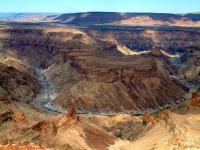 Fish river canyon is arguably the second largest canyon in this world, after the Grand Canyon of Colorado. It is equally impressive and colourful and totally closed for the summer. It is closed for hiking. This is because of the heat and flash flooding. There are absolutely no exceptions and no-one is allowed in the canyon.
Fish river canyon is arguably the second largest canyon in this world, after the Grand Canyon of Colorado. It is equally impressive and colourful and totally closed for the summer. It is closed for hiking. This is because of the heat and flash flooding. There are absolutely no exceptions and no-one is allowed in the canyon.
There are of course numerous viewpoints that tourists can enjoy. Really enjoy. The canyon, like most things in Africa actually, is best viewed soon after sunrise or at sunset when the long shadows and low angle of the sunrays bring all the colour in full vividness and awe.
The river Fish is one of the few that flow continuously but are not included on the list of permanent Namibian rivers. I found it strange but the locals told me that Fish is not deep enough to be called a permanent river although there is always water there.
I was not arguing after seeing that the river was really shallow and it was actually stunning to see how big the canyon was just because of this tiny little river. It actually makes one sit down and think how many millennia it must have taken these wee waters to carve such an amazing monument of nature. It definitely is a wonder of nature.
The great element about this gorgeous gorge is that is so easily accessible for everyone. There are a few barriers around the viewpoints but just outside them, there are no limits and one can get right to the very edge of the precipice. Some may call it dangerous but I call it natural, adventurous and absolute heaven for photographers.
It is actually quite straightforward to photograph the canyon. The viewpoints provide an unusual perspective of the canyon that makes the impression of the picture being taken from the air or in other words an aerial photograph.
Oh yeah, but before I actually got to see the canyon, I was able to see the best campsite and rest place in Namibia – the Ai-Ais Hot Springs.
The hot springs are for real and the resort has one of the most wonderful hot spring swimming pools I have ever seen and swam in. It was massive, and oval – approximately fifty metres (155 feet) long and thirty metres (100 feet) wide. The perfect thing about it was however the roof or rather a lack of it. The roof was the sky. And imagine perfectly clear sky, African sky with stars that cannot normally be seen.
I spent many hours in the pool and breached at least three of the pool regulations. I brought alcohol to it, bathed without proper bathing suit (without any bathing suit actually) and made a lot of noise. I, together with other fellow safari travellers, had an entire bar by this pool with a great variety of drinks. We had beer, Amarula, peppermint, red wine and port. And we were mixing all these, in particular the Amarula with peppermint to make the springboks. There were a few people who trickled in, a guy from the Czech Republic and two guys from Germany. They could not quite believe their eyes what was swimming or rather floating in that pool. It was so perfect that I stayed in the water until 4 am.
It was again not very easy to get up in the morning for the penultimate day of the safari ride. That was the morning for the canyon viewing, so I had to be up. From the canyon, the trip continued towards the Kalahari Desert, which in Namibia is rather a semi desert.
Kalahari is covered with medium sized dark red dunes and plentiful light green bushes and acacia trees. Very National Geographic indeed.
|
Dec 13, 2002 07:00 PM Namibia - The Orange River
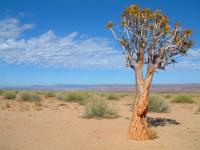 From Luederitz, which I did not enjoy at all, the trip was taking me towards Orange River, the second permanently flowing river in Namibia. No way can it compare with the massive Zambezi, though. It flows right along the border with South Africa (Republic of) in a valley that is however so much prettier than the Zambezi's. It is also hippo and crock free so it is safe to swim in it.
From Luederitz, which I did not enjoy at all, the trip was taking me towards Orange River, the second permanently flowing river in Namibia. No way can it compare with the massive Zambezi, though. It flows right along the border with South Africa (Republic of) in a valley that is however so much prettier than the Zambezi's. It is also hippo and crock free so it is safe to swim in it.
The trip was supposed to take only few hours because the distance was not great. The problem was the car. It broke down. One of the wheels was losing the balancing liquid and there was a risk that it may fall off. So, we had to take a detour away from a rough terrain where the four-wheel drive was necessary. The driver attempted to get it fixed in the nearby township but it was not easy to find a mechanic there. The road along the river that we took was not even on the map.
There were actually benefits of this tour: incredible landscape, visits to amazing townships (picture above) and free grapes. The hectares and hectares of vineyards were so unexpected. Namibia does not really produce wine, so they must be shipped just over the river to South Africa. The grapes were good though and we snatched a few... kilograms (twice as much a few pounds) of them. They were very sweet and ready to pick. So, we picked them.
The other difficulty in getting the car fixed was that almost everyone was relaxing this afternoon. It was in fact Saturday afternoon. The relaxation unfortunately involved alcohol and most of the wonderful people we met were absolutely three sheets to the wind, incommunicado, inebriated, plastered, pickled, pie-eyed, rat-faced, pissed, wasted, plonked, drunken, smashed, cabbaged, intoxicated, sloshed and all in between depending whom we actually met.
Fortunately, one of the vineyards had a mechanics workshop and the wheel could be welded and we did not have to stay tenting in the middle of nowhere.
|
Dec 12, 2002 07:00 PM Namibia - Kolmanskop, Luederitz
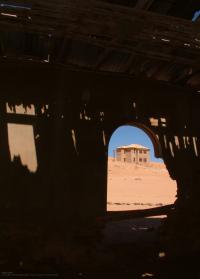 I found all about it in Kolmanskop, a ghost town near Luederitz. They have a museum there, about the diamond picking and then diamond mining. The town is situated right in the restricted area so everyone has to be very careful not to step in a sensitive or prohibited territory.
I found all about it in Kolmanskop, a ghost town near Luederitz. They have a museum there, about the diamond picking and then diamond mining. The town is situated right in the restricted area so everyone has to be very careful not to step in a sensitive or prohibited territory.
The guide told me that the place is armed with CCTV cameras (closed circuit television – meaning recording all the time) and even museum personnel do not know where these cameras are. She also said that everyone should, if at all possible, refrain from picking anything from the ground. She was serious about it, although something tells me that a chance of finding a diamond on the museum’s premises were zero.
Kolmanskop is nevertheless an interesting spot. It follows the German colonial architecture but 95% of the buildings over there are complete ruins that are being constantly swallowed by the desert. There are many pictures of the place and it is quite possible that people usually imagine to see a more isolated place than it is in reality. I am quite sure that if the territory where the ghost town stands had not been restricted within the Diamond Area I, it would have been much wilder. Now, the entire complex is fenced and surrounded by the invisible CCTV cameras.
Although I am not a museums fan, this particular one in Kolmanskop is quite good and it explains more than an average tourist could expect. The narrative goes not only about the place but also about the diamonds, diamond picking, mining, the story about travelling on the desert, the impressive railway built rapidly through the desert in a record time, the war with Germans and then with South African occupation or, like others may say, South African protectorate.
The Ghost Town is still being owned by the Namibian diamond mining corporation, Namdeb, and it is absolutely up to them whether they are going to keep this as a museum or not. They will decide if they are going to inform the museum about anything or not.
The example of that is that the company decided to fully restore some of the finest buildings in the ghost town but the personnel of the museum have absolutely no idea why and for what reason and whether there will be more restoration in the future.
Everything is like a secret over there. It is like those modern CCTV cameras, which allegedly are everywhere but no-one can see them and the museum personnel does not know where they are, and like the desert, which ignores the rules and buries the place.
|
Page:
 103 104 105 106 107 108 109 110 111 112 113
103 104 105 106 107 108 109 110 111 112 113

|
|
|
